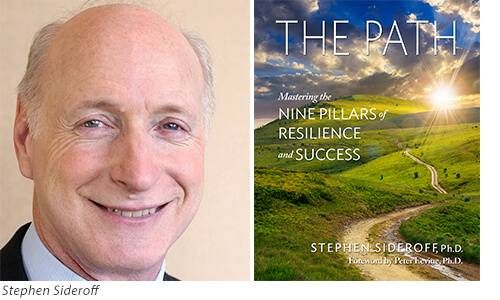Build Your Resilience for Health and Success
It means breaking patterns of dealing with stress, says 'The Path' author
We hear a lot about the importance of resilience: the ability to get through a period of stress, upheaval or trauma with our mental and physical health relatively intact. It is the ability to "bounce back" from adversity that takes us forward in life, instead of staying "stuck" in one painful and unproductive place.
In his new book, The Path: Mastering the Nine Pillars of Resilience and Success, Stephen Sideroff offers what he says are the steps toward breaking old, destructive patterns and creating new ways of dealing with stress.
Sideroff is an assistant professor in the Department of Psychiatry & Biobehavioral Sciences at UCLA and directs the Raoul Wallenberg Institute of Ethics. He also speaks regularly on resilience, optimal performance and alternative treatments for stress.
The following is an excerpt from his book:
The Path
When I began presenting peak performance workshops for executives in 1980, I recognized that one of the most important ingredients to success was learning the concept of flow and being in the zone. These concepts are most frequently mentioned in relation to sports, but they define peak performance in all areas. They refer to a way of functioning in which everything is working together, in alignment.
When you are in the zone you don’t have to think about what you are doing; you just do it, as the Nike trademark says.
It became evident to me that one common denominator for people in the zone or in flow was adaptability. That refers to the ability to learn from experience, continually take in new information and adjust your thinking and behavior to accommodate new lessons of life. Flexible and aware, these peak performers did not get stuck on any one particular way of thinking or acting. Interestingly, these same people were very good at managing the inevitable stresses that accompanied their success.
Successful But Not Satisfied
This led to my own research into successful living. I saw many people who were able to make a lot of money or show good results in their company’s bottom line but whom I would not consider peak performers. Many of them were referred to me by physicians to address their high blood pressure, headaches, or sleepless nights.
Others would find their way to my doorstep for help with conflict-ridden relationships or simply dissatisfaction or unhappiness with their lives. Their performance in business did not translate into peak performance in life.
At the same time, I was working with another group of clients who were feeling stuck in their lives. Despite all their hard work, they never seemed to break through to another level. They got bogged down or overwhelmed by the details of their lives or distracted by ongoing conflicts.
Rigid Thinking
The commonality between these two populations was their difficulty in learning from their mistakes or recognizing how their thinking and attitude interfered with their success. Their thinking was rigid, and they had many blind spots — areas off-limits to their awareness. Weaknesses remained weaknesses. Nowhere was this more evident than in how these clients handled stress.
That’s when I realized that stress — and how effectively one handles stress — are primary modulators of quality of life and success in life. Stress can accentuate a person’s weaknesses, lead to physical and emotional symptoms, and cause a breakdown in various aspects of one’s life. Mastering stress is the hallmark of adaptability and a consistent marker of overall life success. Thus, within my program I make a distinction between business success and life success (although life success can incorporate business success). I refer to this broader and richer concept, sought by executives and others who come to me, as “Resilient Success.”
Seeking Out Stress
No one is immune to the consequences and even the seduction of stress. The more you try to achieve, the more stress you face. But I fully expected participants in my workshops to grasp the straightforward ways to reduce stress and implement more effective coping mechanisms. Instead, over the years I encountered more and more obstacles to success, and to awareness. My clients and workshop participants found more and more creative ways to continually activate their stress response, to be vigilant and to worry, even when they could have been relaxing. This occurred despite evidence that quality and effectiveness in their life were directly impacted by their maladaptive behavior.

Were all these people coming to see me simply caught up in bad fortune? Or was I observing a more universal process — with these clients just the extreme cases?
I began studying and cataloging this all-too-common resistance to reducing stress. Consequences included distraction, loss of focus, fatigue, forgetfulness, and mistakes. (Think of the photos you’ve seen of our recent presidents — photos taken at the start of their presidency and photos taken when they are leaving office. That’s stress and aging before our very eyes!)
The Need to Adapt
This was an eye opener! Despite all the ravages of stress — and a growing accumulation of research demonstrates the destructive impact of stress – people continually engage in behaviors that strain their coping resources and cause widespread physical and emotional destruction. I encountered smart people who were having difficulty engaging in adaptive behaviors. Finally, about 15 years ago, in response to people’s harmful behavior, I developed a new direction for my work, one that focused on the importance of adaptability.
Our stress response is an evolutionary adaptive mechanism. It prepares us for danger. It saves our lives. Instinctually, we are reluctant to curb that response. My research, however, revealed a large maladaptive component to being in almost continual stress alert. Furthermore, this unhealthy pattern carries over into other areas of thinking and performance.
Learning Early
We are intimately attached to patterns developed during childhood. The brain develops and adapts to this earliest learning. What must be kept in mind is that first learning is survival learning — thus, attachment to these lessons holds the highest level of importance and strength. This survival-level importance is coded into our lessons of how the world works and who we are, rendering adaptation to newer
information more difficult. In other words, childhood development can interfere with healthy adult adaptation! We are given the chart of the territory of life and ourselves, but not the keys to make healthy changes to the chart.
In working with clients to address this inherent obstacle, I needed an approach that didn’t trigger resistance with every turn. It’s like the patient who goes to the doctor to relieve a symptom or illness, and the doctor says, “Sir, you have to get to bed earlier, you have to stop smoking, you have to exercise more, stop drinking and you have to lose weight.” And the patient leaves the office saying, “I have to get another doctor.”
Ultimately, this book presents a comprehensive, logical and organized integration of optimal functioning that restores and maintains personal energy. It serves as a blueprint and guidance device for creating greater adaptability. Furthermore, it is designed to work at the deepest levels. After all, the source of personal energy is derived from your deepest self.


